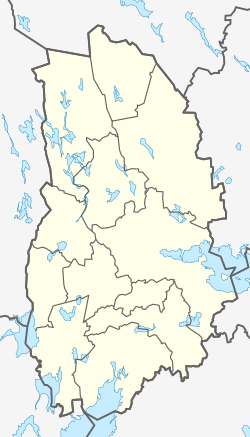Kopparberg | |
|---|---|
 Kopparberg in 1920s | |
| Coordinates: 59°52′N 14°59′E / 59.867°N 14.983°E | |
| Country | Kingdom of Sweden |
| Province | Västmanland |
| County | Örebro County |
| Municipality | Ljusnarsberg Municipality |
| Area | |
| • Total | 6.73 km2 (2.60 sq mi) |
| Population (31 December 2015)[1] | |
| • Total | 4,200 |
| Time zone | UTC+1 (CET) |
| • Summer (DST) | UTC+2 (CEST) |
Kopparberg is a locality and the seat of Ljusnarsberg Municipality, Örebro County, Sweden, with 4,200 inhabitants in 2015.[1] It is famous for one of the most valuable postage stamps in the world, the Treskilling Yellow from 13 July 1857, Kopparberg's wooden church (voted No. 1 in Sweden in 2006), and Kopparberg Cider, now one of the best selling ciders in the UK and worldwide.
This name is traditionally associated with Falun, some 90 km to the north, and gave its name to Kopparbergs län (Kopparberg County, now called Dalarna County) and the 700-year-old mining company Stora Kopparberg, which is now part of Stora Enso. However, the town was founded as late as 1635 with the name Nya Kopparberget. It was named after the copper mines that were, in the 18th century, a major supply of the world's copper, and a considerable contributor to the Swedish national economy. Kopparberg lies on a major north–south road, 80 km north of Sweden's sixth most populous city, Örebro. Örebro is in the middle of Sweden, lying on the east–west 500 km/300 mile E18/E20 highway and also railway lines that directly connect Stockholm, Sweden, to Oslo, Norway. These are some of the busiest in Sweden.
- ^ a b c "Tätorternas landareal, folkmängd och invånare per km2 2005 och 2010" (in Swedish). Statistics Sweden. 14 December 2011. Archived from the original on 27 January 2012. Retrieved 10 January 2012.

